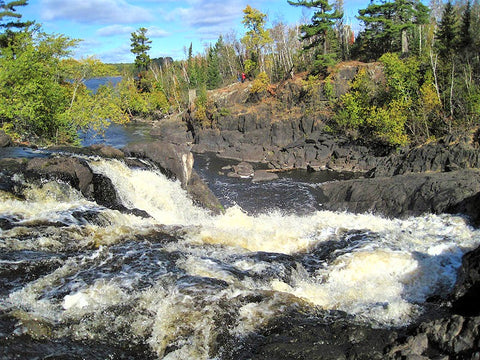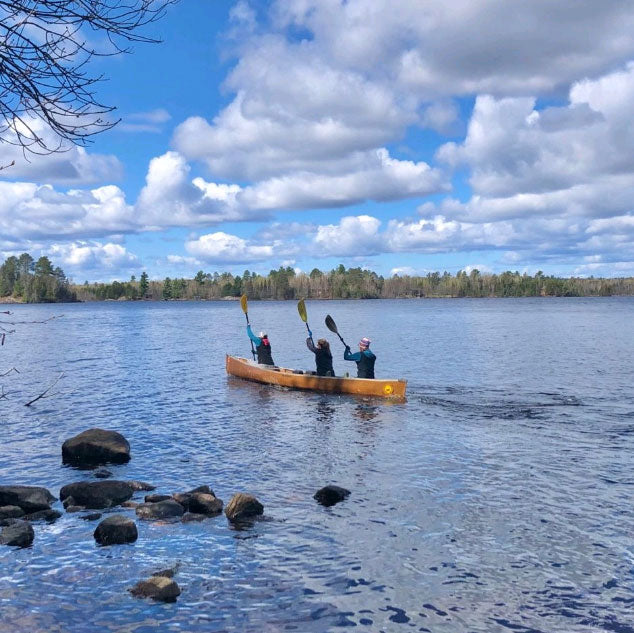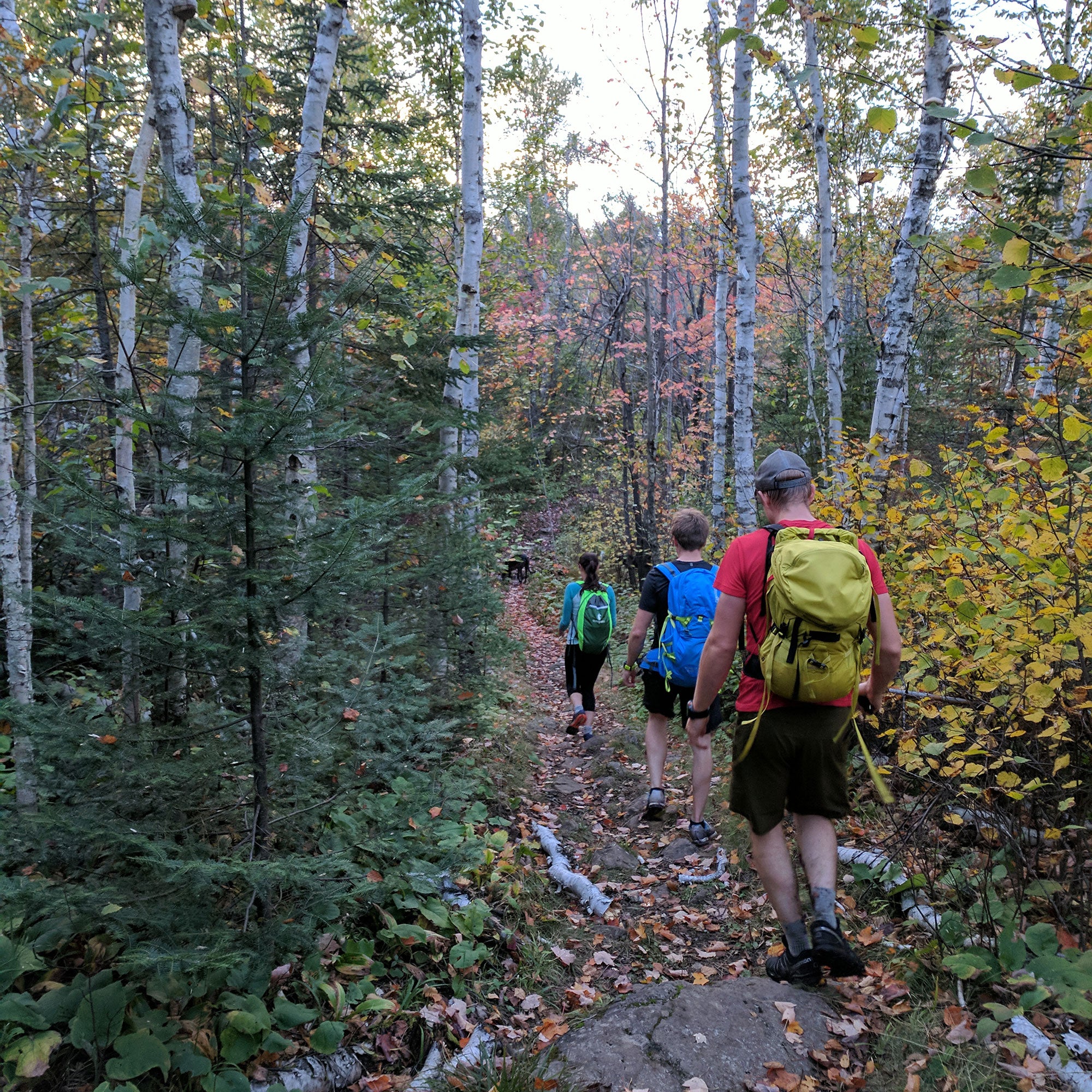
This 1967 photo of me tells you two things:
1) I had a couple younger brothers.
2) My parents had a sense of humor.
Mom & dad also had a sense of adventure. Though thoroughly urban, they knew us rowdy kids needed room to groove beyond the confines of our Minneapolis neighborhood. So in the early ‘60s, they granted us two life-changing outlets.
First, they bought acreage on Wisconsin’s Apple River. There each summer we could cut loose with Huckleberry Finn adventures (and where perplexed visitors were greeted by this sign in the photo). Second, dad involved me with our church’s answer to Boy Scouts: the Lutheran Pioneer Boys. Our troop 173 enjoyed tubing outings to float the quiet wooded waters upstream of our river place and we went on many campouts to area parks.

Here’s my dapper dad, marching us in formation at William O’Brien State Park (That’s me alongside him, carrying my shirt).
When we earned enough merit badges (by learning to fold the flag, tie a square knot, ditch our tents, etc), we were awarded a trip to a mythical place called the Boundary Waters. When my day came, I was wide eyed with wonder on my first visit to northern Minnesota. Dad & I stopped in Chisholm to visit his army buddy Ed Zobitz. Given my intrigue with wild places, the gifts Ed pressed into my hands that day were more precious than gold. The ancient arrowheads and fossil in this photo were discoveries he made in the Northwoods and they still sit on my desk as reminders of that moment. During that Chishom visit with dad, Ed beamed with pride as he showed us where he worked – the Hull Rust Pit, one of the largest iron mines in the world. Then we hopped back in the station wagon to drive to Ely for our canoe trip and Ed said, “Now we’re headed for the good stuff.”

Gifts from Ed.
That first Boundary Waters trip was a life-changing epiphany for me. I remember it like it was yesterday, especially the evening my Pioneer Boy buddies & I were playing kick the can around the campsite while walleyes grilled on the fire & loons yodeled in the orange-glow sunset. Seized by the moment, I stopped to soak in the scene and I knew that somehow, someway I’d call this place home someday.
Thanks to Apple River and Pioneer Boy adventures, my family and I have been called the Northwoods homes for 40 years now. Of course, lots of other stars aligned to make that happen, ample material for other reflective blogs on Wintergreen origins.

Apple River Falls.
My Apple River days triggered my adventure lore. Recently, in one of life’s bittersweet transitions, our family said goodbye to that retreat. With our busy lives, it hasn’t been visited much in recent years and it's time for others to enjoy it. Following our final family gathering there, Sue and I drove backroads and byways to follow the Apple to its headwaters in north central Wisconsin. That gave me a chance to reflect on some of the Apple’s curious features. Perhaps you’ll enjoy them also, and the remarkable connections that special place has with my life today:
1) Among Wisconsin’s 12,600 rivers & streams, the Apple ranks 10th longest at nearly 80 miles. The river, which drops 600’ on its way to the St. Croix & gains volume with 12 tributaries, once provided water power for 10 mills & power dams. As a child, I was fascinated by the Riverdale Power Dam just downstream from our place. The hum of the turbines was mesmerizing and the fishing was great! In 1965, when the Star Prairie Dam upstream from us blew out with spring floods, mom and dad raced us up there to see the wreckage. Rebar & concrete blocks were tossed everywhere but the powerhouse remained intact. I peered in the window and was startled to see there at the operator’s desk his brown bag lunch with contents scattered as he’d beat a hasty exit when the dam burst. Now we live just upstream from a powerhouse as well, the Kawishiwi Dam between Garden and Fall Lake. Built 100 years ago, it produces 4 MW - just like the Apple River dams still do - which happens to match the power needs of Ely. It’s located just above these beautiful falls, much like the Apple River falls one shown above.

Kawishiwi Falls.
2) The first European to visit the Apple River was Daniel Greysolon, who poked up it on his way down the St. Croix in 1680. A French explorer & nobleman, he was searching for the mythical Northwest Passage connecting the Atlantic & Pacific. Also known as Sieur (“Lord”) Duluth, he built a fort that became his namesake city. Five years ago a rock with his name & date carved in it was found not far from the Apple. But the Passage he was searching for, which he had learned of from native American lore, lay further north -- it follows the border lakes route in our Boundary Waters.
3) A missionary Rev. Verwyst arrived in 1870 and documented the area’s Ojibwe and Sioux residents who lived peacefully with the settlers. He recorded the Apple River’s Ojibwe name as “Waabizii-pinikaan-ziibi” which means “River abundant with Swan Potatoes” (which is the Arrowroot plant that has edible potato-like root tubers). French settlers translated that as potato “pomme de terre” (apple of the earth), but only the “Apple” part stuck (lucky us or we’d be calling it Potato River) Rev. Verwyst also recorded Ojibwe names in the Ely area. His manuscripts are a key source for a Native Lake Names Map that my colleagues and I with the Ely Folk School are creating for the Boundary Waters area. For example, we’ve found that our lake’s original name is Wabishka biwabiko = “White Iron”.
4) During Prohibition era, the Apple River area became the “Midwest Capitol of Moonshine.” Farmers cooked up to 100 gallons of booze/day. By the late ‘20s, the feds caught up with most area bootleggers, but Somerset hooch continued to flow till 1940 because the close-knit French Canadian community had no ‘snitchers.’ Among my favorite childhood Apple River discoveries was finding remains of a moonshine still on an island, which my brothers and I displayed in our makeshift “Frontier Village” museum along with other treasures from the woods.
5) Our Apple River put-in point for afternoon canoe outings was the Outpost Bar & Grill on a country road upstream from our place. A sleepy joint in our youth, we’re proud to know it’s now in the Guinness Book of World Records for creating the worlds longest hot dog & bun (84 feet!) as a 2006 fundraiser for riverside playground equipment.

Tubers on the Apple River.
6) The Apple’s most famous business, River's Edge, a restaurant founded in 1931, was a sleepy operation with a fledging tubing business until 1972 when Charles Kuralt arrived to float the river for an “On the Road” CBS special. The show proved so popular that the tubing phenomena exploded from a few hundred to over 20,000 weekend tubers. Kuralt, who frequented Ely in the 90’s for fishing fun & declared it his top vacation spot, helped support our WELY radio when it was on the skids and many of us provided volunteer programming. On a couple occasions, Kuralt joined Steve Piragis and I in the announcer’s booth to tag team the “Wintergreen Adventure Hour”. In 1997, he sang “Happy Birthday Bria” on her 12thover the airwaves of Ely.

Charles Kuralt.
7) The Apple flows through four wildlife refuges & includes a short world-class stretch of whitewater canoeing at Pike Hole Gorge near Little Falls. This gorge is where a fiberglass canoe dad & I had built from a Sears/Robuck kit in 1969 broke in half on Day 3 when a friend & I hit a precipice while descending the Apple from Amery. Us two crestfallen kids dragged the split canoe to a county road where dad picked us up. On this ‘live off the land’ trip, we anticipated fish every night but couldn’t snag any & by Day 2 got hungry. Then we discovered hundreds of minnows trapped in sandbar pools – our manna from heaven. We sauteed them like hash – tasty!

Ancient artifacts.

Pottery shard.
8) Strand Lake near our Apple River property is a rich archeological site with a large burial mound & source of numerous artifacts. And an island at the Apple’s mouth on the St. Croix is a renowned Obijwe burial site where ancient stone grave markers are still apparent. My favorite Apple River discovery moment was finding, at age 12, the etched & ochered pottery shard shown above. A badger had unearthed it in diggings along our river bank and it may be from an Ojibwe burial pot. That and the arrowheads dad’s army buddy gave me fostered my fascination with our region’s rich native American legacy So did the stone axe, hammer & spearheads shown above that my brothers and I found at our childhood outlet for adventure in Minneapolis: Theodore Wirth Park & Forest Reserve. Sue and I got married there, October 10, 1981. We proposed to each other on the Apple River. During our 40 years canoeing and dogsledding the Quetico-Superior, we continue sleuthing for echoes of our region’s native residents and have found 3 previously undocumented pictograph sites.

Paul & Sue's wedding at Theodore Wirth Park following proposal at Apple River.
In life’s great game of ‘connect the dots’, as we reflect on how we got to where we are, I find that my Apple River days are my beginning waypoint. For that I say, thank you mom and dad!

Roger & Lois at a fundraising dinner for Lutheran Pioneer Boys.

Paul Schurke - Polar Explorer
Paul Schurke is the owner and operator of Wintergreen Dogsled Lodge. When he's not on trail or with guests, he can probably be found out on an exciting adventure in the wilderness.




1 comment
Joyce Flock
Paul,I love your memoirs and loved reading your book North to the Pole,right after you and Will Steger got it out in print. It was an honor to meet you at Wintergreen when we experienced your wonderful dogsledding adventure. I have been an admirer of yours for many years and you got.my car off your icy driveway. Thanks a million
Paul,I love your memoirs and loved reading your book North to the Pole,right after you and Will Steger got it out in print. It was an honor to meet you at Wintergreen when we experienced your wonderful dogsledding adventure. I have been an admirer of yours for many years and you got.my car off your icy driveway. Thanks a million